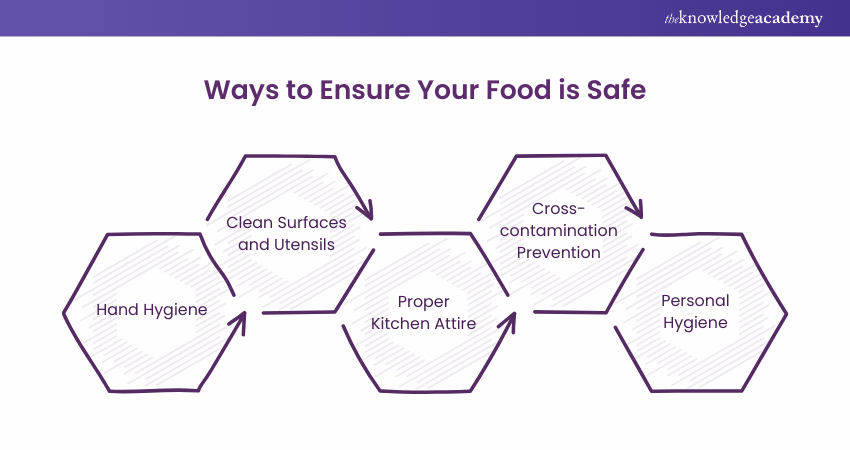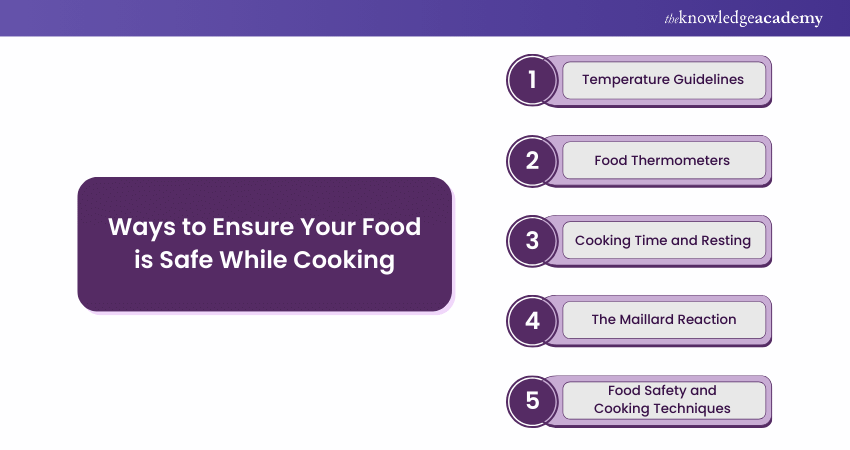We may not have the course you’re looking for. If you enquire or give us a call on 01344 203999 and speak to our training experts, we may still be able to help with your training requirements.
Training Outcomes Within Your Budget!
We ensure quality, budget-alignment, and timely delivery by our expert instructors.

Keeping our meals healthy and germ-free is super important, whether you’re cooking at home or dining out. By following a few simple guidelines, you can make a big difference. In this blog, we’ll dive into the 4 Steps to Food Safety: Cleanliness, Separation, Cooking, and Chilling. These steps are not only easy to follow but also ensure that your food is both safe and delicious. Ready to learn how to protect yourself and your loved ones from foodborne illnesses? Let’s get started with these practical and life-saving tips! Practical tips!
Table of Contents
1) Importance of Food Safety
2) What are the 4 Steps to Food Safety?
a) Step 1- Cleanliness
b) Step 2- Separation
c) Step 3- Cooking
d) Step 4- Chill
3) Conclusion
Importance of Food Safety
Food Safety ensures that what we eat is safe and free from harmful germs and chemicals. Here are the Benefits of Good Food Safety.
a) Prevents Illness: Safe food practices help stop foodborne illnesses, which can cause stomach aches, vomiting, and even more serious health problems.
b) Protects Health: Clean and safe food keeps our bodies healthy and strong. Contaminated food can lead to long-term health issues.
c) Builds Trust: When food businesses follow safety guidelines, people trust them more. This trust is important for business success.
d) Reduces Waste: By handling and storing food properly, we can prevent it from spoiling. This helps reduce waste and saves money.
What are the 4 Steps to Food Safety?
It is important to make sure that the food we eat is not contaminated and is healthy to consume. So, let’s discuss the 4 Steps to Food Safety and see how we can keep our food safe:
Step 1- Cleanliness
When it comes to food safety, cleanliness is key. It ensures that the food we eat is safe and delicious. You've probably heard the saying "Cleanliness is next to Godliness" – it fits perfectly here, especially when preparing food.
Keeping the kitchen clean and maintaining personal hygiene sets the stage for making delicious and safe meals. It helps avoid things that could make us sick from the food we eat. So, staying clean is not just good for making meals – it’s essential for keeping us healthy and safe. Here are key points to keep in mind:

a) Hand Hygiene: Always wash your hands thoroughly before starting any cooking task. Remember to wash your hands after touching raw foods and handling waste. This simple act greatly reduces the risk of spreading germs and foodborne illnesses.
b) Clean Surfaces and Utensils: Keep your kitchen surfaces and utensils clean. Regularly disinfect cutting boards, countertops, knives, and other equipment to eliminate harmful bacteria. Different surfaces might need different cleaning methods, so be sure to follow the right techniques.
c) Proper Kitchen Attire: What you wear in the kitchen matters. Wearing clean, appropriate kitchen attire, like an apron, can prevent loose clothing from contaminating food. This small step can make a big difference in food safety.
d) Cross-contamination Prevention: Prevent cross-contamination by keeping raw and cooked foods separate. Harmful microorganisms can transfer from one food item to another, causing foodborne illnesses. Strict separation of raw and cooked foods is crucial.
e) Personal Hygiene: Your personal hygiene is also important. If you’re feeling unwell or have symptoms of illness, avoid preparing food. Actions like sneezing, coughing, or touching your face can introduce germs into the food. Minimise these actions while cooking to keep food safe.
Learn essential food safety practices with our Building Your Food Safety Culture Training – Join today!
Step 2- Separation
Separation is crucial to prevent cross-contamination, which is the transfer of microorganisms from one food item to another. Here’s how to keep your food safe: Always be mindful of how you handle and store different types of food to ensure they remain uncontaminated.
a) Raw and Cooked Foods: Always keep raw and cooked foods separate. Store raw meats and seafood on the lower shelves. Use separate cutting boards, utensils, and knives for raw and cooked foods to avoid transferring harmful bacteria.
b) Storage Strategies: Use airtight containers to store raw ingredients and prevent their juices from leaking. Keep raw meats in a separate section or container to avoid any potential leakage.
c) Ready-to-eat Foods: Keep ready-to-eat foods like fruits and vegetables away from raw meats and other potential contaminants. Wash these items thoroughly before eating to remove any surface bacteria.
d) Utensil and Tool Separation: Use separate utensils and cooking tools for raw and cooked foods. Clean and sanitise knives, stirring spoons, tongs, and other utensils after using them with raw foods before using them with cooked foods.
e) Cooking Order: Prepare raw items first and ready-to-eat items last to reduce the chances of contamination. Avoid placing cooked foods on surfaces that have come into contact with ingredients without proper cleaning.
Step 3- Cooking
Cooking is not merely the transformation of raw ingredients into dishes; it's also a powerful tool in the step of Food Safety. The application of heat during cooking serves as a weapon against harmful bacteria, viruses, and parasites that may take cover within our food. Here' how you can ensure Food Safety while cooking:

a) Temperature Guidelines: When it comes to cooking, temperature matters. Different foods have specific internal temperature guidelines that must be reached to ensure their safety. For instance, poultry should be cooked to an internal temperature of 75°C (165°F), while ground meats need to reach 71°C (160°F).
b) Food Thermometers: A food thermometer is a small tool that can significantly impact Food Safety. Insert the thermometer into the thickest part of the food, away from bone or fat, to accurately gauge its internal temperature. This practice is particularly vital for larger cuts of meat, where uneven cooking can pose a risk.
c) Cooking Time and Resting: Beyond reaching the correct internal temperature, adequate cooking time and resting are crucial steps in the process. Cooking times specified in recipes are often designed to ensure that the entire dish reaches the desired temperature.
d) The Maillard Reaction: Cooking is not just about safety; it's also about flavour development. The Maillard reaction, which occurs when proteins and sugars react at high temperatures, is responsible for the browning and development of complex flavours in cooked foods. This reaction not only enhances taste but also contributes to the overall appeal of a dish.
e) Food Safety and Cooking Techniques: Different cooking techniques also play a role in Food Safety. When using methods like grilling, frying, or roasting, ensure that the food's internal temperature reaches the recommended level. These high-heat methods can effectively eliminate harmful pathogens, but only if the proper temperatures are achieved.
Step 4- Chill
Chilling food is not just about keeping it cold; it's a crucial step in the process of Food Safety. Proper chilling helps slow the growth of harmful bacteria, preserving the quality and safety of food. Here's how you can ensure Food Safety while chilling:
a) Refrigeration Temperature: Maintaining the right temperature in your refrigerator is essential. Keep your fridge set at or below 4°C to slow down bacterial growth. Frequently check the temperature to ensure it stays within the safe range.
b) Proper Storage: How you store your food in the fridge can impact its safety. Store meat and poultry on the lowest shelf to avoid juices from dripping onto other foods. Use airtight containers or wrap food properly to prevent contamination and maintain freshness.
c) Cooling Hot Foods: It's important to cool hot foods quickly before refrigerating them. Divide big portions of hot food into smaller, shallow containers to speed up the cooling process. Avoid placing hot food into the fridge, as it can raise the overall temperature and compromise the safety of other stored items.
d) Thawing Methods: The way you thaw frozen food is crucial for Food Safety. Thaw food in the fridge, in cold water, or in the microwave, but never on the counter. These methods ensure that the food stays at a safe temperature while defrosting, preventing the growth of harmful bacteria.
e) Food Safety and Chilling Techniques: Different chilling techniques play a role in Food Safety. When using methods like quick chilling or flash freezing, ensure that the food is rapidly brought to a safe temperature. These techniques are particularly useful for preserving the quality and safety of perishable items.
Understand the importance of clean equipment with our Food Safety Manager Training – Join today!
Conclusion
Ensuring Food Safety is simple and crucial for our health. By following the 4 Steps to Food Safety, you can save yourself and your loved ones from foodborne illnesses. Remember to keep everything clean, separate raw foods, cook to the right temperatures and chill food properly. These small actions make a big difference in keeping your meals safe and delicious. Start practising these steps today for a healthier tomorrow!
Learn food preservation techniques with our Food Hygiene and Safety in Manufacturing Training – Join today!
Frequently Asked Questions

Store any remaining food in airtight containers and refrigerate it within two hours of cooking. Make sure your fridge is set at or below 40°F (4°C).

Clean your kitchen surfaces, including countertops and cutting boards, after each use. This stops the spread of harmful bacteria and keeps your food safe.

The Knowledge Academy takes global learning to new heights, offering over 30,000 online courses across 490+ locations in 220 countries. This expansive reach ensures accessibility and convenience for learners worldwide.
Alongside our diverse Online Course Catalogue, encompassing 17 major categories, we go the extra mile by providing a plethora of free educational Online Resources like News updates, Blogs, videos, webinars, and interview questions. Tailoring learning experiences further, professionals can maximise value with customisable Course Bundles of TKA.

The Knowledge Academy’s Knowledge Pass, a prepaid voucher, adds another layer of flexibility, allowing course bookings over a 12-month period. Join us on a journey where education knows no bounds.

The Knowledge Academy offers various Food Hygiene and Safety Training, including the Food Safety and Hygiene Course, Food Hygiene and Safety in Manufacturing Training, and Food Safety Manager Training. These courses cater to different skill levels, providing comprehensive insights into Food Safety.
Our Health & Safety Blogs cover a range of topics related to Food Safety, offering valuable resources, best practices, and industry insights. Whether you are a beginner or looking to advance your Health & Safety knowledge, The Knowledge Academy's diverse courses and informative blogs have got you covered.
Upcoming Health & Safety Resources Batches & Dates
Date
 Food Safety and Hygiene Course
Food Safety and Hygiene Course
Fri 28th Mar 2025
Fri 23rd May 2025
Fri 4th Jul 2025
Fri 5th Sep 2025
Fri 5th Dec 2025







 Top Rated Course
Top Rated Course



 If you wish to make any changes to your course, please
If you wish to make any changes to your course, please


